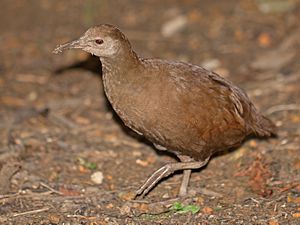Lord Howe woodhen facts for kids
Quick facts for kids Lord Howe woodhen |
|
|---|---|
 |
|
| Conservation status | |
| Scientific classification | |
| Synonyms | |
|
The Lord Howe woodhen (Hypotaenidia sylvestris) is a special type of bird that cannot fly. It belongs to the rail family. This bird lives only on Lord Howe Island, which is off the coast of Australia. The IUCN currently lists it as an endangered animal. This means there are not many of them left in the wild.
Contents
What Does the Woodhen Look Like?
The Lord Howe woodhen is a small bird with olive-brown feathers. It has a short tail and a bill (beak) that curves downwards. Its wings are a chestnut color with darker stripes. The eyes of the woodhen have a bright red center.
Where Do Woodhens Live and What Do They Eat?
These birds live in sub-tropical forests. They mostly eat earthworms, small crustaceans (like tiny crabs), and fruit. Sometimes, they might also eat the eggs of other birds like shearwaters and petrels.
Woodhen Family Life
Woodhens choose a mate for life and are usually seen in pairs. They are very protective of their home area. If they hear an unusual noise, they will often come out of the forest to check it out. A mated pair will defend an area about three hectares (which is about the size of three football fields). Once their young birds grow up, the parents make them leave this area. This means the number of woodhens is limited by how much suitable land is available for them.
How the Woodhen Was Saved
When explorers first found Lord Howe Island in 1788, there were 15 different bird species, including many woodhens. Because woodhens cannot fly, are naturally curious, and had never been hunted, they were an easy food source for sailors and early settlers. After settlers arrived in 1834, nine of these 15 bird species became extinct.
Decline in Numbers
The number of woodhens kept dropping. By the late 1970s, there were fewer than 30 birds left. They were only found in the hard-to-reach mountain tops of Mount Gower and Mount Lidgbird. In 1980, the woodhen was almost gone, with only 15 birds remaining.
Saving the Species
Scientists studied why the woodhen population was shrinking. They found that wild pigs were the main problem. These pigs were eating the woodhen eggs and chicks. To save the woodhen, the pigs and other harmful animals, like goats, were removed from the island.
A special program called ex-situ conservation (meaning "off-site conservation") also started in May 1980. This involved breeding the woodhens in captivity. The first egg was laid in June 1980. The Foundation for National Parks & Wildlife gave $150,000 to build the breeding center and pay the scientists.
Woodhen Population Recovery
Thanks to these efforts, the Lord Howe woodhen population grew. By 2007-08, there were about 250 birds on the island. This might be the perfect number for the island's size. In 2016, there were 232 adult birds.
The way the woodhen was saved is now a great example for conservation biology. This field studies how to protect plants and animals. Many things could have caused the woodhen's decline, like introduced rats or Tasmanian masked owls. But removing the pigs was the most important step to save the species from extinction. Finding the right cause and solution quickly was key to the program's success.
After saving the woodhen, similar efforts have helped other unique species on Lord Howe Island. These include the Lord Howe flax snail (Placostylus bivaricosus) and the Lord Howe currawong (Strepera graculina crissalis).
Images for kids
See also
 In Spanish: Rascón de la Lord Howe para niños
In Spanish: Rascón de la Lord Howe para niños




